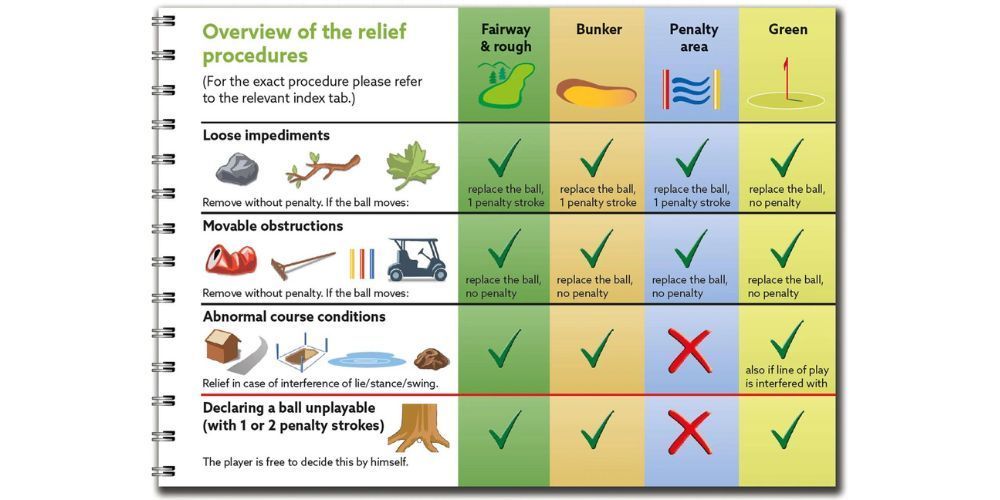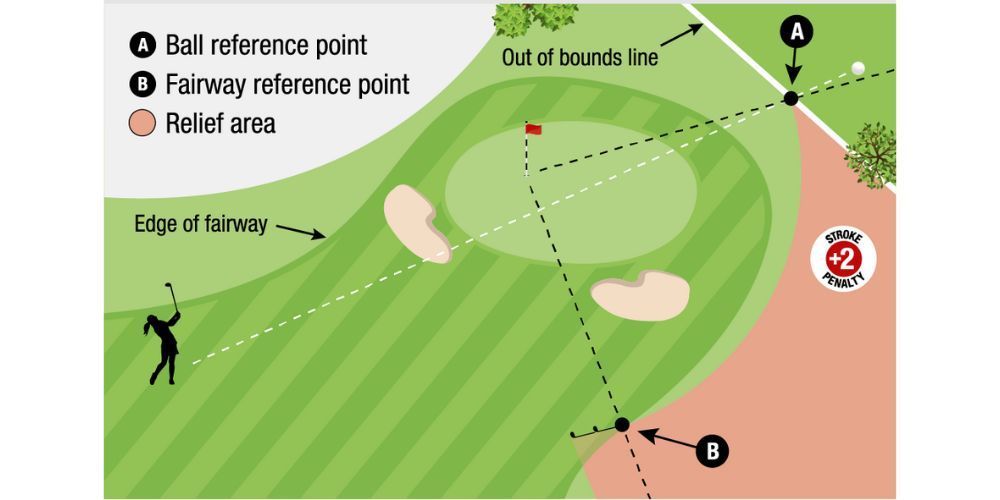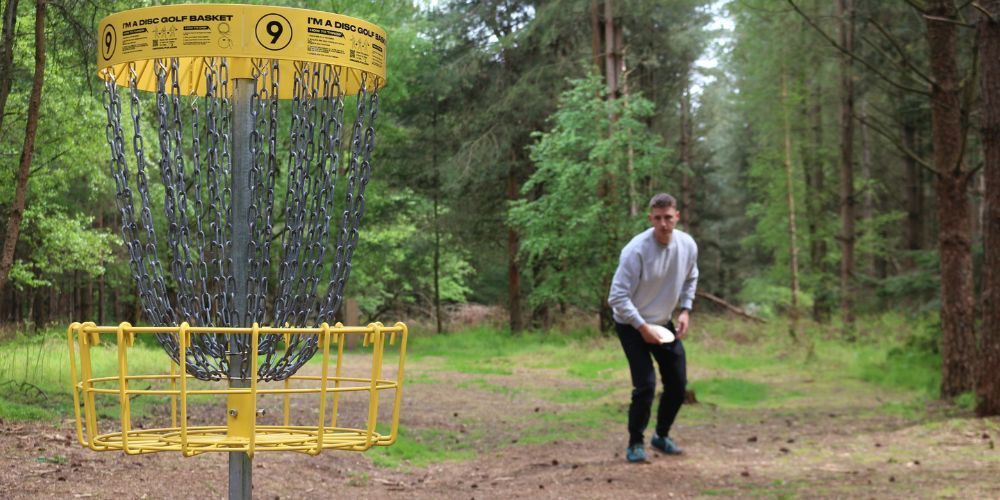Understanding Common Golf Rules and Penalties: An In-Depth Explanation
August 8, 2024
Ever found yourself questioning whether you’ve nailed down all golf rules perfectly mid-game? Even seasoned golfers occasionally double-check their stance or swing, worrying if they missed some critical detail. Understanding the essential golf rules thoroughly not only dissolves such uncertainties but also empowers you with boosted confidence on the green.
In crafting this exhaustive guide, we’ve delved deeply into rulebooks and tapped insights from professional circles to ensure nothing is overlooked. You might find it surprising that these regulations do more than just maintain order—they refine your gameplay strategy moment by moment. Let’s explore those basic yet pivotal guidelines that shape every round of golf you play.
One common golf rule is playing with more than 14 clubs, which incurs a two-stroke penalty per hole where excess clubs are used. Additionally, failing to mark the ball's spot after lifting it typically leads to a one-stroke penalty.

Key Golf Rules Explained
Golf is a game with a rich history and tradition, and at the heart of it are the rules that govern fair play and ensure competition integrity. To enjoy the game to its fullest and compete in a respectful manner, it's crucial to be familiar with these rules.
Rule 1.1 - The Game
Understanding Rule 1.1 is like comprehending the core principles that govern the entire game of golf. Every round of golf is bound by this rule, unless specifically modified by local club rules. This foundational rule sets the stage for how the game is played, ensuring that players adhere to the agreed-upon standards across all courses.
When you're well-versed in this rule, you're equipped with the knowledge of what makes golf a universal language spoken by enthusiasts around the world.
In essence, Rule 1.1 embodies the spirit of golf, framing it as more than just a game, but as a deeply-rooted tradition and culture shared by millions globally. By upholding this rule, players pay homage to the legacy and heritage of the sport.
Rule 3 - Stroke Play and Match Play
Rule 3 introduces us to two fundamental formats of play in golf: stroke play and match play. Understanding these distinctions not only enables players to participate confidently in any form of competition but also sets the groundwork for strategic gameplay.
Stroke play involves counting the total number of strokes taken across the entire round. It's like compiling a comprehensive story about each shot you take on your journey through all 18 holes. On the other hand, match play operates on a hole-by-hole basis, where victory is claimed by the player with the fewest strokes per hole.
By grasping these contrasting approaches to scoring, players gain valuable insight into how to approach their game strategically, adjusting their tactics according to the format being played.
Rule 6.3 - Player Responsibility
Rule 6.3 emphasizes player accountability on the course. Players are entrusted with upholding essential responsibilities such as maintaining pace of play guidelines, teeing up punctually, and ensuring that they do not fall behind during their round.
This rule demands an elevated sense of consideration for fellow players on the course, fostering an environment where everyone can enjoy their game without hindrance or unnecessary delays.
These key rules form the backbone of golf etiquette and set the stage for an enjoyable and fair game. Understanding them fosters a deep appreciation for the sport's traditions while enriching your playing experience on the course.
Out of Bounds and Hazards
Picture your ball soaring down the fairway, only to meet an abrupt end in a thicket of bushes or over a fence. That's what we call an out of bounds (OB) area in golf. When your ball crosses the boundary lines of the course, you incur a penalty.
The penalty for hitting a ball out of bounds is straightforward: you must take a one-stroke penalty and re-hit from the original spot. The stroke and distance rule can be unforgiving, adding an extra layer of pressure to your game as you strive to avoid those OB areas at all costs.
Red and Yellow Stakes
Hazard areas are strategically marked with colored stakes to signal potential danger. When you see red or yellow stakes, it's time to pay close attention, as they indicate specific hazards and the options available to you when your ball lands within them.
A yellow stake designates a direct water hazard, such as a pond or lake. If your ball ends up in this hazard, you have the option to drop the ball back on the line it entered, taking a penalty stroke but allowing for a more favorable position for your next shot.
On the other hand, red stakes signify a lateral water hazard, which presents different drop options should your ball find its way there. In this case, you have more flexibility in where you can drop your ball, with additional options available within two club lengths from where the ball crossed the margin of the hazard. This nuanced approach allows players to navigate these lateral water hazards strategically while adhering to the rules.
Rule for Lost Ball
The panic sets in as you frantically scan the area for your lost ball, especially since you only have three minutes to find it before it's considered "lost." If your search proves futile within this timeframe, a one-stroke penalty is imposed, and you must re-hit from the original spot. In a sport defined by precision and strategy, losing a ball can be not only frustrating but also costly in terms of both score and time.
These rules are designed to ensure fair play and maintain integrity on the golf course. As we continue to explore golf rules and penalties in depth, we see how these regulations shape the game and influence players' decisions on the course.
As we step onto the next tee box, let's further dissect the consequences of recording an incorrect score and how it can impact a player’s standing in a game.
Penalties for Incorrect Scores
In golf, precision is crucial, not just in your swing, but also in how you document your scores. Imagine if a player's scorecard doesn't accurately reflect their performance. It could lead to an unfair advantage and potential disqualification. Therefore, it's paramount for each player to be meticulous in guaranteeing that their scorecard is free from errors before submission.
The penalties for an incorrect score hinge on whether the mistake results in an understated or overstated score.
Penalty for Lower Score than Actually Taken
A player submitting a lower score than what they actually achieved on any hole faces a significant penalty—they risk disqualification from the competition. This might seem stringent, but it's essential to maintain fair play and uphold the game's integrity. After all, golf stands on a foundation of honesty and personal responsibility.
Penalty for Higher Score than Actually Taken
Conversely, if a player inadvertently records a higher score than what they actually made on a hole, the higher score stands without further penalty. Although there may not be additional punishment for overstating a score, this doesn't diminish the importance of accurate scoring. Each golfer should take great care to record their scores as precisely as possible, as those reported numbers have a real impact on their standing in the competition and their fellow players' game.
Here's an example: If a player scores 4 on a hole but mistakenly records it as 3, their incorrect submission could unfairly change the outcome of the competition. This underscores why accurate scoring is so crucial to maintaining fairness and sportsmanship in golf.
"It's worth emphasizing that these penalties are in place not to punish players but to ensure fair play and respect for the sport's traditions of honesty and accountability."
Now, with a clearer understanding of the severity of inaccuracies in golf scores, let's dive into the rules governing the number of clubs a player can carry—a seemingly small detail with potentially significant consequences.

Club Limitations: The 14-Club Rule
The 14-club rule may sound simple, but its importance cannot be overstated in the game of golf. This rule implies that players are allowed to carry a maximum of 14 clubs during a round, and exceeding this limit carries significant penalties. Enforced by the United States Golf Association (USGA) and the R&A, the 14-club rule is a cornerstone of maintaining fairness and equality in competitive play.
This rule might seem straightforward at first glance, but it actually demands strategic club selection from each player. Choosing the right combination of clubs is not just about following the rules—it can significantly impact a player's performance on the course. Players have to consider their own strengths as well as the specific challenges posed by the course layout.
Strategic Club Selection
Players must make conscious decisions when selecting their 14 clubs, balancing them according to their skillset and the characteristics of the course. For instance, they may need to determine how many woods, irons, wedges, and putters will give them a winning edge.
Each player has distinct strengths and weaknesses which guide their choice of clubs. A golfer with a powerful swing may prioritize long-distance shots using different woods, while someone who excels at finesse may require several types of irons and wedges.
Let's take a closer look at why this rule exists in the first place—it's all about maintaining a level playing field and ensuring that no player gains an unfair advantage over others.
The 14-club maximum was established to prevent professional players or advanced amateurs from overwhelming less skilled opponents with an excessive number of specialty clubs tailored for every possible scenario. Furthermore, it serves to simplify the game by requiring players to be more versatile with fewer options at their disposal. This creates an environment where skill, adaptability, and strategy are valued over relying solely on equipment.
Consider it as a chef preparing a dish with limited ingredients—each ingredient must be carefully selected to create a perfect blend of flavors, much like combining golf clubs to achieve optimal performance on the course.
In summary, beyond being a standard regulation for all golfers, this rule encourages thoughtful play and ensures that success hinges more on skill than access to an extensive arsenal of equipment. It's about leveling the playing field and raising the bar for genuine sportsmanship by promoting resourcefulness and adaptability over sheer abundance.
Exploring these pivotal golf rules sheds light on why adherence to them is crucial for maintaining integrity in the sport. Now, let's pivot our focus to another essential aspect—the impact of ball movement and its associated penalties on game outcomes.
Ball Movement and Associated Penalties
The subtleties of ball movement in golf can lead to crucial moments on the course, and it's essential to understand how they are handled under the rules. Accidental ball movement is a common occurrence, and knowing the penalties associated with it can significantly impact your game. According to the rules, if a player accidentally moves their ball, they incur a one-stroke penalty unless the movement occurs while searching for the ball. It's crucial to be mindful of even the smallest unintentional motions during play, as they can affect your score.
Now, when it comes to natural forces, they can also influence the movement of the ball. If the ball is moved by wind or gravity, there is no penalty, and the ball must be played from its new position. This rule acknowledges that external factors beyond the player's control can lead to a change in the ball's position, thus exempting them from penalties for such movements.
Furthermore, Rule 9.4 addresses situations where a player's ball moves after they have taken their stance. In general, if the motion is caused by something other than the player—such as wind or gravity—there is typically no penalty incurred. However, if the movement is attributed to the player themselves, then a one-stroke penalty is applied. This highlights the importance of remaining still and composed upon addressing the ball, as any subsequent movement can result in penalties.
Understanding these nuances surrounding ball movement and its associated penalties allows players to navigate unexpected occurrences on the course effectively and helps maintain fairness and integrity during play.
Whether it’s accidental movement or motion due to natural forces, being aware of these rules ensures that players can address such situations confidently and continue to play fairly and competitively.
By accounting for these different scenarios related to ball movement, golfers can approach their game with greater precision and insight into how various factors may influence gameplay. Adherence to these specific regulations also ensures that competition remains fair and preserves the integrity of the sport.
With a solid understanding of common golf rules and penalties, let's now move on to explore special situations involving unplayable lies and relief.

Special Situations: Unplayable Lies and Relief
So, what happens when your ball ends up in an impossible spot, like stuck behind a big tree, or deep in a thorny bush? In such cases, a player may declare the lie unplayable and take relief. But there's a catch—this isn't allowed in water hazards. A water hazard involves either a stream, ditch, lake or wetlands. For this situation, other rules come into play which we will cover later.
When declaring an unplayable lie, it's important to know your options for relief. The rules provide three choices:
- Replaying From the Original Spot: This option allows you to take a stroke and drop the ball back at the original location where your last shot was played. It's vital to remember that this comes with a one-stroke penalty.
- Dropping Within Two Club Lengths: Here, you can take another stroke and drop the ball within two club lengths of the original position. Again, this incurs a one-stroke penalty.
- Dropping Back on a Line: If you prefer to keep things simple by deciding which point to drop from, this option lets you take another stroke and drop the ball back on a line from the hole through the ball’s position within any distance. Once more, it is followed by a one-stroke penalty.
By granting these relief options, the rules ensure fairness and flexibility for the player in difficult situations. These rules exist to uphold integrity and fairness in the game of golf and to maintain competitive balance.
Relief from an unplayable lie gives golfers a chance to recover from a bad position without unfairly penalizing them while ensuring they don't get away scot-free for ending up in a tough spot.
Imagine finding yourself stuck right near an out-of-bounds area with no viable shot—it's precisely times like these when understanding your options for relief becomes crucial.
Understanding these particular rules can be a lifesaver when you find yourself in tricky spots during a round of golf. They offer an escape hatch from challenging situations and can make all the difference between finishing strong or struggling throughout a game.
Mastering these specific rules lays the groundwork for building a steady game without falling prey to avoidable penalties. Now, let's shift our focus to expert strategies aimed at steering clear of common pitfalls on the golf course.
Expert Tips for Avoiding Penalties
Golf isn't just a physical game; it's a mental one too. Whether you're a novice or a seasoned player, avoiding penalties can be challenging, but there are strategies to help you stay penalty-free. Let's explore some practical tips to keep you in the game and prevent those pesky penalty strokes.
Know the Local Rules
Each golf course is unique and might have its own set of local rules. These rules could save you from unnecessary penalties—something as simple as knowing that a certain area is considered ground under repair can make a big difference in your play. It's crucial to always read the scorecard or check the board at the clubhouse to familiarize yourself with any relevant local rules.
Consistent Practice Matters
The more you practice, the lesser your chances of making errors that lead to penalties. Regularly honing your swing, stance, and course navigation can help minimize these mistakes. It's not just about hitting balls at the driving range—it's also about simulating real game scenarios and working on specific aspects of your play that directly affect your performance during a round of golf.
Leverage Technology
In this age of technology, we have an abundance of resources to help us navigate through various aspects of our lives, and golf is no exception. Apps like the USGA Rules of Golf can be your best friend on the course. When in doubt about a rule during a round, these apps provide quick rule searches and clarify any uncertainties, empowering you to make informed decisions on the go.
These tools are especially valuable for newcomers who aren't yet familiar with all the rules - when you're not sure whether it's okay to take relief from a certain area or if you're entitled to free relief from an abnormal course condition, having access to instant guidance can make all the difference.
By staying informed about local rules, consistent practice, and leveraging technology on the course, you'll be setting yourself up for success and minimizing the chances of incurring pesky penalties during your rounds. These strategies not only enhance your performance but also contribute to a more enjoyable and fulfilling golf experience.
Implementing these strategies will not only bolster your game but also increase your enjoyment of this popular pastime. Happy golfing!
What are the most common golf rules every player should know?
Golf has many rules, but some are crucial for every player to understand to ensure fair play and enjoyment of the game. Here are a few key rules:
Teeing Area: You must tee your ball within the designated area. You can go two club lengths behind the markers but not in front of them.
Ball In Play: Once you’ve teed off, the ball is considered “in play” and should be played as it lies unless the rules allow for relief or replacement.
Out of Bounds: If your ball lands out of bounds, you’re required to take a stroke-and-distance penalty. This means replaying your shot from the original spot and adding one penalty stroke.
Unplayable Lie: If your ball is in a position where you can’t hit it, you have options for relief, each costing one penalty stroke. You can go back to the original spot, drop the ball within two club lengths, or go back on the line of play.
Water Hazards: When your ball lands in a water hazard, you typically have the option to play it as it lies, or you can drop a new ball outside the hazard and take a one-stroke penalty.
Knowing these rules can help you navigate the course confidently and keep your scorecard accurate.
What are the penalties for violating common golf rules?
Penalties in golf can vary based on the nature of the rule breach. Here are some of the most common penalties you might encounter:
Stroke-and-Distance Penalty: Often applied for out-of-bounds shots or lost balls, this penalty requires you to replay the shot from its original position with an added penalty stroke.
One-Stroke Penalty: This can occur in various situations, such as taking relief from a water hazard or an unplayable lie. You may drop the ball within a specific area, but it costs you an additional stroke.
Two-Stroke Penalty: More severe infractions, like playing the wrong ball or improving your lie, can result in a two-stroke penalty. Always ensure you’re hitting the correct ball and avoid altering the natural course conditions.
Disqualification: Serious breaches of the rules, such as signing an incorrect scorecard or failing to adhere to etiquette, can lead to disqualification from a tournament.
Understanding these penalties can help you make better decisions on the course and maintain the integrity of your game.
Can you touch the sand with your club before hitting a shot in a bunker?
No, you cannot touch the sand with your club before hitting a shot in a bunker. According to the golf rules, it is considered a penalty if you touch the sand with your club or ground it in the bunker before making your shot. This rule is in place to ensure fair play and prevent players from improving their lie or conditions in the bunker. As of 2024, statistics show that this rule remains unchanged and is enforced by golf authorities worldwide.
Are there any specific rules for how to mark and replace your ball on the green?
Yes, there are specific rules for marking and replacing your ball on the green in golf. According to the United States Golf Association (USGA) Rule 14-1b, a player must mark the position of their ball before lifting it, usually using a small coin or ball marker. They can then clean the ball if necessary and replace it precisely in its original spot. This rule is essential to maintain fairness and consistency during play, ensuring that players have an accurate reference point when putting.
How is stroke play different from match play when it comes to applying penalties?
In stroke play, penalties are added to a player's score when a rule is broken, affecting their total score for the round. In match play, penalties may result in the loss of a hole or incur penalty strokes, but they do not impact the overall score like in stroke play. This key difference stems from the varying objectives of the two formats – stroke play focuses on individual score while match play centers around winning individual holes. Understanding these distinctions is crucial for players to adapt their strategies and approach to penalties accordingly.
What is the ruling if your ball lands in a water hazard?
If your ball lands in a water hazard, the ruling is that you have three options: 1) Play the ball as it lies, but remember that the hazard penalty applies if you touch or ground your club in the hazard. 2) Drop a ball behind the water hazard, keeping the spot where the original ball last crossed the hazard between you and the hole, with no limit on how far back you can go. 3) Replay the shot from your original position under penalty of one stroke. According to statistics, choosing the option that helps you avoid the hazard altogether tends to be more beneficial in terms of overall score.
What is the penalty for hitting the ball out of bounds in golf?
The penalty for hitting the ball out of bounds in golf is stroke and distance. This means that you must add one penalty stroke to your score, and then go back to the spot where you originally hit the shot and re-hit it. According to statistics from the PGA Tour in 2023, players hit out of bounds on average 1.7 times per tournament, resulting in an average of 1.5 penalty strokes per round.
How can I avoid common penalties in golf?
Avoiding penalties in golf is about being informed and prepared. Here are some tips to help you steer clear of common mistakes:
Study the Rule Book: Familiarize yourself with the basic rules of golf. Carry a rule book or a digital version on your phone for quick reference.
Mark Your Ball: When playing with others, mark your ball with a unique symbol to ensure you don’t mistakenly hit someone else’s ball.
Practice Proper Etiquette: Follow golf etiquette by repairing divots, raking bunkers, and being mindful of other players on the course.
Be Aware of Hazards: Before hitting, take note of any water hazards, out-of-bounds areas, or other course challenges. Plan your shots accordingly to minimize risk.
Ask for Clarification: If you’re uncertain about a rule or situation, don’t hesitate to ask a fellow player or a course official for guidance.
These practices can help you enjoy the game more and keep your score in check by avoiding unnecessary penalties.
Check out the latest guides on golfing gear
Author: William Flaiz










